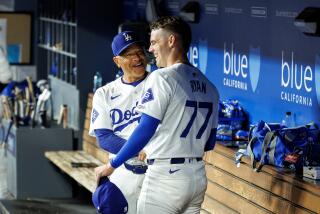For Dodgers, First Base Is a <i> Not</i> Corner
Back in the days when the Dodgers were in Brooklyn, the gag was that it was the only town in the big leagues without a newspaper, a railroad station--or a left fielder, of its own.
The team moved clear to Los Angeles to solve the problem. They got a newspaper, a railroad station, and Wally Moon. What they now didnât have was a subway--and a third baseman.
Actually, the Dodgers had plenty of third basemen, something like 57 in all. There were so many of them they were thinking of incorporating. If so, their corporate logo should be âE-5.â
When you have 57 of something, of course, you have none of something. As the guy said of the firm that had seven vice presidents, âThatâs an awful lot of bottom for one chair.â
They were consistent. They couldnât field or hit. Fresco Thompson used to curl his lip and say the only times they got to third base was with a glove. They were turning third into the cold corner.
But, then, Ron Cey came along--and the problem moved 120 feet east.
First base had never been a Dodger problem since the days of the mustache cup and the horse trolley. âWhoâs on first?â was not a tough question for a Dodger fan. There was a Jake Daubert, a Jacques Fournier (he used to hit .350 with the best of them), Del Bissonette, Sam Leslie, Buddy Hassett, Dolph Camilli and finally the incomparable Gil Hodges, who practically retired the position.
Then, Wes Parker was probably as pretty a performer around the bag as the franchise had seen, but it was Steve Garvey who became the prototypical L.A. Dodger first baseman.
The trouble with Steve was that he was monotonous. He never missed a game, a curve, a throw. He got 200 hits a year, 20-30 home runs and 100 RBIs. He was as dependable as a butler and as reverent as an altar boy.
You could see where this kind of everyday perfection would eat at you and, anyway, the Dodgers were convinced Garvey was holding up a pipeline of Hall of Fame first basemen they had down in the minor leagues. Or, in the case of Albuquerque, up in the minor leagues. They were all batting .600 or so and, in the thin air of New Mexico, hitting home runs that stayed up for days like satellites.
No one stopped to think how many Garvey might have hit in an atmosphere where the balls donât curve and the hits donât come down, but, the facts of the matter were, the Dodgers could have signed Garvey if they wanted to. All he wanted was money. And they were paying that to guys who were sitting around Las Vegas swimming pools.
The Dodgers now had a team that consisted entirely of first basemen--except for third base. They had a left fielder (Pedro Guerrero) playing there.
They gave first base to Greg Brock on the basis he had more Albuquerque home runs than anyone and they scattered the rest of the first basemen through the lineup like confetti. They told Mike Marshall to learn to play right field--or learn to drive a bus. They told Franklin Stubbs he was a left fielder no matter what anyone told him. They traded for Enos Cabell and Bill Madlock, both of whom could, and had, played first base. They hauled Sid Bream back and forth from Albuquerque so much he was as eligible for the frequent flyer program as an eagle.
Then, they gave the job to Len Matuszek, a reserve outfielder and a career pinch-hitter.
Apparently, General Manager Al Campanis, a year or so ago, was finally able to put his finger on what was wrong with the Dodger team--it had too many Sids. So, he got rid of Sid Fernandez for Bob Bailor and Carlos Diaz. And he got rid of Sid Bream for Bill Madlock.
Sidney Eugene Bream is a man who never batted below .300 in the minor leagues in his life. He could hit a line drive off a machine gun was the word coming out of the batting cages. At 6-foot-4, 218 pounds and left-handed, he was as natural at first base as the second coming of Lou Gehrig.
In 1985, he hit .409 in spring training with the Dodgers. He went 8 for 10 in the Freeway Series against the Angels. He opened the season hitting three home runs to lead the Dodgers. So, the parent club optioned him back to Albuquerque on April 25. He promptly batted .323 and was recalled again on May 18. He got in a few more games, then was optioned back to Albuquerque in June with a suggestion he learn to play outfield. He was recalled on June 23, then re-optioned to Albuquerque on July 10.
He hit .370 in Albuquerque.
In 1984, Sid Bream was batting .362 in Albuquerque in June when the Dodgers recalled him on July 3. They sent him back on July 31.
This human yo-yo still managed to lead the Pacific Coast League in RBIs and homers and assists. His lifetime minor league batting mark was .329. His Albuquerque mark was .336.
He wondered what the Dodgers wanted--chimes? Him to sing the national anthem? Drive the team bus? Do the laundry?
âI decided Iâd had enough,â Sid Bream was recalling as he sat in a dugout at Dodger Stadium the other night. âThey were using me as some kind of insurance. I was either on an airplane or on a bench.
âI went to Tommy Lasorda and he said it was Al Campanisâ decision. I went to Al Campanis and he said it was Tommy Lasordaâs decision. They had me in a rundown. I decided it was my decision. I asked to be traded.â
As Sid Bream came into Dodger Stadium with the Pittsburgh Pirates over the weekend, he was batting .271 with 10 home runs and 35 RBIs. He was also playing first base.
Over on the Dodgers, first basemen were playing everywhere but.
Franklin Stubbs was holding down left field and he has 15 home runs and 36 RBIs and a .266 average. Mike Marshall, injured but holding down right field when not, has 17 home runs, a .266 average and 46 RBIs. Greg Brock, also injured, is batting .213 with 8 home runs and 24 RBIs.
âWhoâs on first?â has become a very big problem for the Dodgers. âWhoâs not on firstâ may be the even bigger one. It may be a bigger problem than not having a railroad station, a daily paper or a left fielder. You can win a pennant without one of those.
More to Read
Are you a true-blue fan?
Get our Dodgers Dugout newsletter for insights, news and much more.
You may occasionally receive promotional content from the Los Angeles Times.








